Correlations among Quality Characteristics of Green Asparagus Affected by the Application Methods of Elevated CO₂ Combined with MA Packaging
Abstract
1. Introduction
2. Materials and Methods
2.1. Plant Materials, CO₂ Treatments, Packaging Material and Storage Conditions
2.2. Microbiology Analysis
2.3. Changes in Quality Parameters of Green Asparagus
2.4. The Effect of High CO₂ on Phenol, Flavonoids and DPPH of Green Asparagus
2.5. Gas Conditions and Respiration Rate
2.6. Statistical Data Analysis
3. Results
3.1. Changes in Quality Parameters of Green Asparagus
3.1.1. Fresh Weight Loss (FWL)
3.1.2. Firmness
3.1.3. Color Parameters
3.1.4. Soluble Solids Content (SSC)
3.2. The Effect of High CO₂ on Phenol, Flavonoids and DPPH of Green Asparagus
3.3. Gas Conditions in Packages and Respiration Rate
3.4. Microorganism Analysis
3.5. Sensory Quality and Relative Impacts of Asparagus Quality Attributes
3.6. Correlations and Principal Components Analysis
4. Conclusions
Author Contributions
Funding
Acknowledgments
Conflicts of Interest
References
- Mangaraj, S.; Goswami, T.K. Modified atmosphere packaging of fruits and vegetables for extending shelf-life-A review. Fresh Prod. 2009, 3, 1–31. [Google Scholar]
- Wang, J.W.; Jiang, Y.G.; Li, G.D.; Lv, M.; Zhou, X.; Zhou, Q.; Fu, W.W.; Zhang, L.; Chen, Y.F.; Ji, S.J. Effect of low temperature storage on energy and lipid metabolisms accompanying peel browning of ‘Nanguo’ pears during shelf life. Postharvest Biol. Technol. 2018, 139, 75–81. [Google Scholar] [CrossRef]
- Yoon, H.S.; Choi, I.L.; Han, S.J.; Kim, J.Y.; Kang, H.M. Effects of Precooling and Packaging Methods on Quality of Asparagus Spears during Simulated Distribution. Prot. Hortic. Plant Fact. 2018, 27, 7–12. [Google Scholar] [CrossRef]
- Liu, E.C.; Niu, L.F.; Yi, Y.; Wang, L.M.; Ai, Y.W.; Zhao, Y.; Wang, H.X.; Min, T. Expression Analysis of ERFs during Storage under Modified Atmosphere Packaging (High-concentration of CO2) of Fresh-cut Lotus Root. Hortscience 2020, 55, 216–223. [Google Scholar] [CrossRef]
- Kader, A.A. Postharvest Technology of Horticultural Crops, 3rd ed.; University of California, Agriculture and Natural Resources: Davis, CA, USA, 2002. [Google Scholar]
- Huyskens-Keil, S.; Herppich, W.B. High CO2 effects on postharvest biochemical and textural properties of white asparagus (Asparagus officinalis L.) spears. Postharvest Biol. Technol. 2013, 75, 45–53. [Google Scholar] [CrossRef]
- Sanchez-Ballesta, M.T.; Romero, I.; Jimenez, J.B.; Orea, J.M.; Gonzalez-Urena, A.; Escribano, M.I.; Merodio, C. Involvement of the phenylpropanoid pathway in the response of table grapes to low temperature and high CO₂ levels. Postharvest Biol. Technol. 2007, 46, 29–35. [Google Scholar] [CrossRef]
- Romero, I.; Casillas-Gonzalez, A.C.; Carrazana-Villalba, S.J.; Escribano, M.I.; Merodio, C.; Sanchez-Ballesta, M.T. Impact of high CO2 levels on heat shock proteins during postharvest storage of table grapes at low temperature. Functional in vitro characterization of VVIHSP18.1. Postharvest Biol. Technol. 2018, 145, 108–116. [Google Scholar] [CrossRef]
- Qian, L.; He, S.Q.; Liu, X.W.; Huang, Z.J.; Chen, F.J.; Gui, F.R. Effect of elevated CO2 on the interaction between invasive thrips, Frankliniella occidentalis, and its host kidney bean, Phaseolus Vulgaris. Pest Manag. Sci. 2018, 74, 2773–2782. [Google Scholar] [CrossRef]
- Li, D.; Li, L.; Xiao, G.N.; Limwachiranon, J.; Xu, Y.J.; Lu, H.Y.; Yang, D.M.; Luo, Z.S. Effects of elevated CO2 on energy metabolism and gamma-aminobutyric acid shunt pathway in postharvest strawberry fruit. Food Chem. 2018, 265, 281–289. [Google Scholar] [CrossRef]
- Kafkaletou, M.; Christopoulos, M.V.; Tsantili, E. Short-term treatments with high CO2 and low O2 concentrations on quality of fresh goji berries (Lycium barbarum L.) during cold storage. J. Sci. Food Agric. 2017, 97, 5194–5201. [Google Scholar] [CrossRef]
- Wang, L.X.; Choi, I.L.; Lee, J.H.; Kang, H.M. The Effect of High CO2 Treatment and MA Packaging on Asparagus Quality and Shelf Life during Cold Storage. J. Agric. Life Environ. Sci. 2019, 31, 41–49. [Google Scholar]
- Yoon, H.S.; Choi, I.L.; Kang, H.M. Different Oxygen Transmission Rate Packing Films during Modified Atmosphere Storage: Effects on Asparagus Spear Quality. Hortic. Sci. Technol. 2017, 35, 314–322. [Google Scholar]
- Cao, J.K.; Jiang, W.B.; Zhan, Y.M. Experiment Guidance of Postharvest Physiology and Biochemistry of Fruits and Vegetables, 1st ed.; China Light Industry Press: Beijing, China, 2007. [Google Scholar]
- Oboh, G. Effect of blanching on the antioxidant properties of some tropical green leafy vegetables. Lwt-Food Sci. Technol. 2005, 38, 513–517. [Google Scholar] [CrossRef]
- Sharma, H.K.; Kaur, J.; Sarkar, B.C.; Singh, C.; Singh, B.; Shitandi, A.A. Optimization of Pretreatment Conditions of Carrots to Maximize Juice Recovery by Response Surface Methodology. J. Eng. Sci. Technol. 2006, 1, 158–165. [Google Scholar]
- Rashidi, M.; Bahri, M.H.; Abbassi, S. Effects of relative humidity, coating methods and storage periods on some qualitative characteristics of carrot during cold storage. Am.-Eurasian J. Agric. Environ. Sci. 2009, 5, 359–367. [Google Scholar]
- Rashidi, M.; Gholami, M. Prediction of carrot firmness based on water content and total soluble solids of carrot. Afr. J. Agric. Res. 2011, 6, 1831–1834. [Google Scholar]
- An, J.S.; Zhang, M.; Wang, S.J.; Tang, J.M. Physical, chemical and microbiological changes in stored green asparagus spears as affected by coating of silver nanoparticles-PVP. Lwt-Food Sci. Technol. 2008, 41, 1100–1107. [Google Scholar] [CrossRef]
- Verlinden, S.; Silva, S.M.; Herner, R.C.; Beaudry, R.M. Time-dependent Changes in the Longitudinal Sugar and Respiratory Profiles of Asparagus Spears During Storage at 0 °C. J. Am. Soc. Hortic. Sci. 2014, 139, 339–348. [Google Scholar] [CrossRef]
- Kaewsuksaeng, S.; Urano, Y.; Aiamlaor, S.; Shigyo, M.; Yamauchi, N. Effect of UV-B irradiation on chlorophyll-degrading enzyme activities and postharvest quality in stored lime (Citrus latifolia Tan.) fruit. Postharvest Biol. Technol. 2011, 61, 124–130. [Google Scholar] [CrossRef]
- Zhao, S.S.; Yang, Z.; Zhang, L.; Luo, N.; Li, X. Effect of combined static magnetic field and cold water shock treatment on the physicochemical properties of cucumbers. J. Food Eng. 2018, 217, 24–33. [Google Scholar] [CrossRef]
- Christ, B.; Hortensteiner, S. Mechanism and Significance of Chlorophyll Breakdown. J. Plant Growth Regul. 2014, 33, 4–20. [Google Scholar] [CrossRef]
- Yamauchi, N.; Watada, A.E. Chlorophyll and xanthophyll changes in broccoli florets stored under elevated CO2 or ethylene-containing atmosphere. HortScience 1998, 33, 114–117. [Google Scholar] [CrossRef]
- Nakata, Y.; Izumi, H. Microbiological and Quality Responses of Strawberry Fruit to High CO2 Controlled Atmosphere and Modified Atmosphere Storage. Hortscience 2020, 55, 386–391. [Google Scholar] [CrossRef]
- Li, D.; Zhang, X.C.; Li, L.; Aghdam, M.S.; Wei, X.X.; Liu, J.Q.; Xu, Y.Q.; Luo, Z.S. Elevated CO2 delayed the chlorophyll degradation and anthocyanin accumulation in postharvest strawberry fruit. Food Chem. 2019, 285, 163–170. [Google Scholar] [CrossRef]
- Zhao, S.S.; Yang, Z.; Zhang, L.; Luo, N.; Wang, C. Effects of different direction of temperature jump treatment on cucumbers. J. Food Process Eng. 2018, 41, e12600. [Google Scholar] [CrossRef]
- Zurawicz, A.; Krzesinski, W.; Knaflewski, M. Changes in Soluble Solid Content in Green Asparagus Spears during Harvest Season. Acta Hortic. 2008, 776, 435–444. [Google Scholar] [CrossRef]
- Nourian, F.; Ramaswamy, H.S.; Kushalappa, A.C. Kinetics of quality change associated with potatoes stored at different temperatures. Lwt-Food Sci. Technol. 2003, 36, 49–65. [Google Scholar] [CrossRef]
- Li, T.H.; Zhang, M. Effects of modified atmosphere package (MAP) with a silicon gum film window on the quality of stored green asparagus (Asparagus officinalis L) spears. Lwt-Food Sci. Technol. 2015, 60, 1046–1053. [Google Scholar] [CrossRef]
- Sanchez-Ballesta, M.T.; Jimenez, J.B.; Romero, I.; Orea, J.M.; Maldonado, R.; Urena, A.G.; Escribano, M.I.; Merodio, C. Effect of high CO2 pretreatment on quality, fungal decay and molecular regulation of stilbene phytoalexin biosynthesis in stored table grapes. Postharvest Biol. Technol. 2006, 42, 209–216. [Google Scholar] [CrossRef]
- Mikulic-Petkovsek, M.; Slatnar, A.; Veberic, R.; Stampar, F.; Solar, A. Phenolic response in green walnut husk after the infection with bacteria Xanthomonas arboricola pv. juglandis. Physiol. Mol. Plant Pathol. 2011, 76, 159–165. [Google Scholar] [CrossRef]
- Toivonen, P.M.A.; Hodges, D.M. Abiotic Stress in harvested fruits and vegetables. In Abiotic Stress in Plants-Mechanisms and Adaptations; Shanker, A., Venkateswarlu, B., Eds.; IntechOpen: London, UK, 2011; p. 442. [Google Scholar]
- Kogure, K.; Goto, S.; Nishimura, M.; Yasumoto, M.; Abe, K.; Ohiwa, C.; Sassa, H.; Kusumi, T.; Terada, H. Mechanism of potent antiperoxidative effect of capsaicin. Biochim. Biophys. Acta 2002, 1573, 84–92. [Google Scholar] [CrossRef]
- Chandra, D.; Lee, J.S.; Hong, Y.P.; Park, M.H.; Choi, A.J.; Kim, J.G. Short-term application of CO2 gas: Effects on physicochemical, microbial, and sensory qualities of “Charlotte” strawberry during storage. J. Food Saf. 2019, 39, e12597. [Google Scholar] [CrossRef]
- Sgherri, C.; Pérez-López, U.; Micaelli, F.; Miranda-Apodaca, J.; Mena-Petite, A.; Muñoz-Rueda, A.; Quartacci, M.F. Elevated CO2 and salinity are responsible for phenolics-enrichment in two differently pigmented lettuces. Plant Physiol. Biochem. 2017, 115, 269–278. [Google Scholar] [CrossRef] [PubMed]
- Tomás-Barberán, F.A.; Espín, J.C. Phenolic compounds and related enzymes as determinants of quality in fruits and vegetables. J. Sci. Food Agric. 2001, 81, 853–876. [Google Scholar] [CrossRef]
- Wang, S.Y.; Bunce, J.A.; Maas, J.L. Elevated carbon dioxide increases contents of antioxidant compounds in field-grown strawberries. J. Agric. Food Chem. 2003, 51, 4315–4320. [Google Scholar] [CrossRef]
- Gariepy, Y.; Raghavan, G.S.V.; Castaigne, F.; Arul, J.; WillemotI, C. Precooling and Modified Atmosphere Storage of Green Asparagus. J. Food Process. Preserv. 1991, 15, 215–224. [Google Scholar] [CrossRef]
- Simón, A.; Gonzalez-Fandos, E. Influence of modified atmosphere packaging and storage temperature on the sensory and microbiological quality of fresh peeled white asparagus. Food Control 2011, 22, 369–374. [Google Scholar] [CrossRef]
- Bartz, J.A.; Brecht, J.K. Postharvest Physiology and Pathology of Vegetables; CRC Press: Boca Raton, FL, USA, 2002. [Google Scholar]
- Lipton, W.J. Postharvest Biology of Fresh Asparagus. In Horticultural Reviews; Janick, J., Ed.; JohnWiley and Sons: Hoboken, NJ, USA, 2011; pp. 69–155. [Google Scholar]
- Jutatip, P.; Hidemi, I. Shelf Life and Microbial Quality of Fresh-cut Mango Cubes Stored in High CO2 Atmospheres. J. Food Sci. 2005, 70, 6. [Google Scholar]
- Vazquez-Hernandez, M.; Navarro, S.; Sanchez-Ballesta, M.T.; Merodio, C.; Escribano, M.I. Short-term high CO2 treatment reduces water loss and decay by modulating defense proteins and organic osmolytes in Cardinal table grape after cold storage and shelf-life. Sci. Hortic. 2018, 234, 27–35. [Google Scholar] [CrossRef]
- Rao, L.; Bi, X.F.; Zhao, F.; Wu, J.H.; Hu, X.S.; Liao, X.J. Effect of high-pressure CO2 processing on bacterial spores. Crit. Rev. Food Sci. Nutr. 2016, 56, 1808–1825. [Google Scholar] [CrossRef]
- Mohn, G. Modified atmospheres. In The Microbiological Safety and Quality of Foods; Lund, B.M., Baird-Parker, A.C., Gould, G.W., Eds.; Springer Science & Business Media: Gaithersburg, MD, USA; Aspen, CO, USA, 2000; pp. 214–234. [Google Scholar]
- Tudela, J.A.; Marin, A.; Garrido, Y.; Cantwell, M.; Medina-Martinez, M.S.; Gil, M.I. Off-odor development in modified atmosphere packaged baby spinach is an unresolved problem. Postharvest Biol. Technol. 2013, 75, 75–85. [Google Scholar] [CrossRef]
- Lin, Q.; Lu, Y.Y.; Zhang, J.; Liu, W.; Guan, W.Q.; Wang, Z.D. Effects of high CO2 in-package treatment on flavor, quality and antioxidant activity of button mushroom (Agaricus bisporus) during postharvest storage. Postharvest Biol. Technol. 2017, 123, 112–118. [Google Scholar] [CrossRef]
- Herppich, W.B.; Huyskens-Keil, S. Cell wall biochemistry and biomechanics of harvested white asparagus shoots as affected by temperature. Ann. Appl. Biol. 2008, 152, 377–388. [Google Scholar] [CrossRef]
- Herppich, W.B.; Huyskens-Keil, S.; Hassenberg, K. Impact of Ethanol Treatment on the Chemical Properties of Cell Walls and Their Influence on Toughness of White Asparagus (Asparagus officinalis L.) Spears. Food Bioprocess Technol. 2015, 8, 1476–1484. [Google Scholar] [CrossRef]
- Lu, H.Y.; Wang, K.D.; Wang, L.; Li, D.; Yan, J.W.; Ban, Z.J.; Luo, Z.S.; Li, L.; Yang, D.M. Effect of superatmospheric oxygen exposure on strawberry (Fragaria x ananassa Fuch.) volatiles, sensory and chemical attributes. Postharvest Biol. Technol. 2018, 142, 60–71. [Google Scholar] [CrossRef]
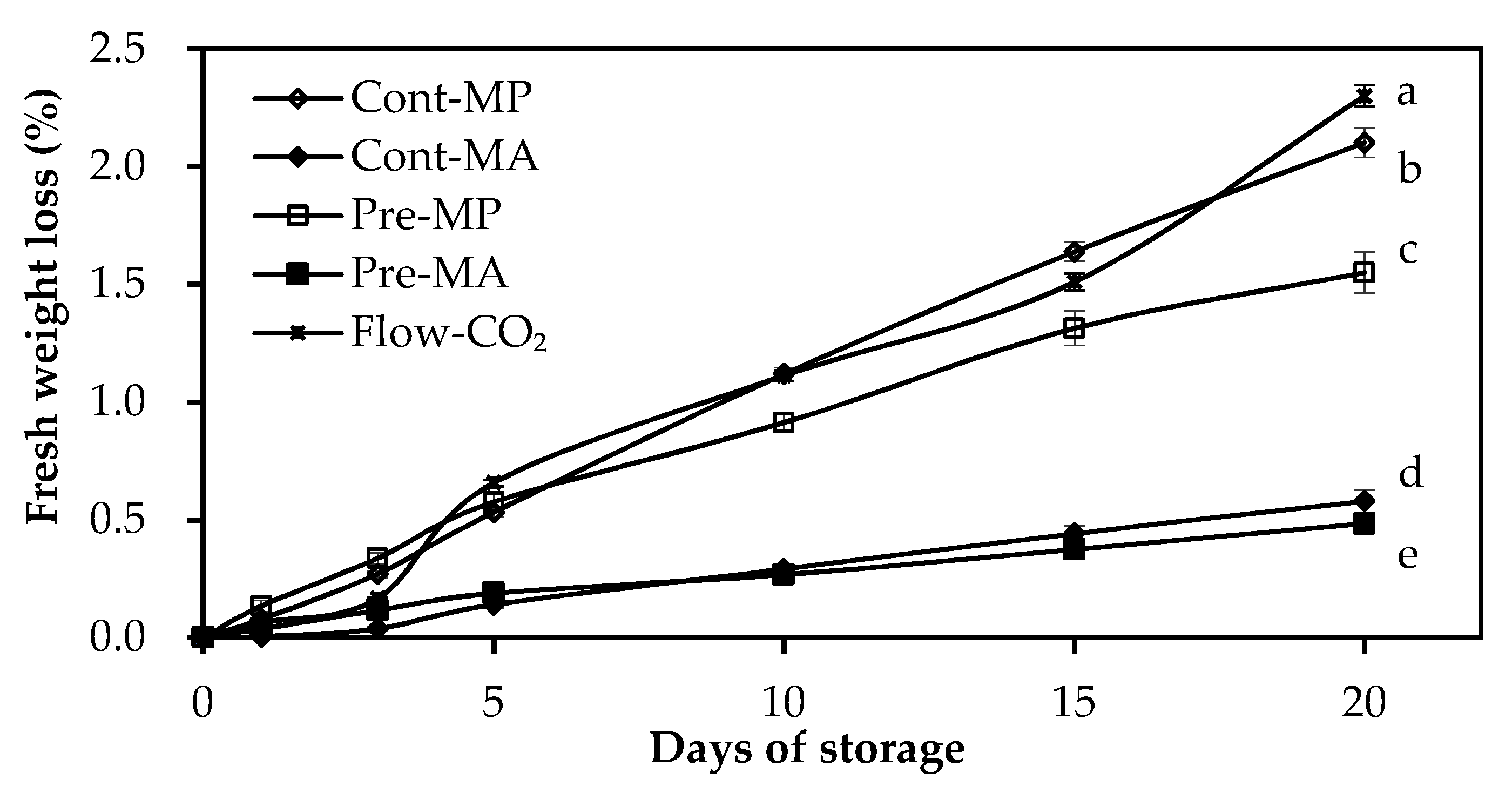
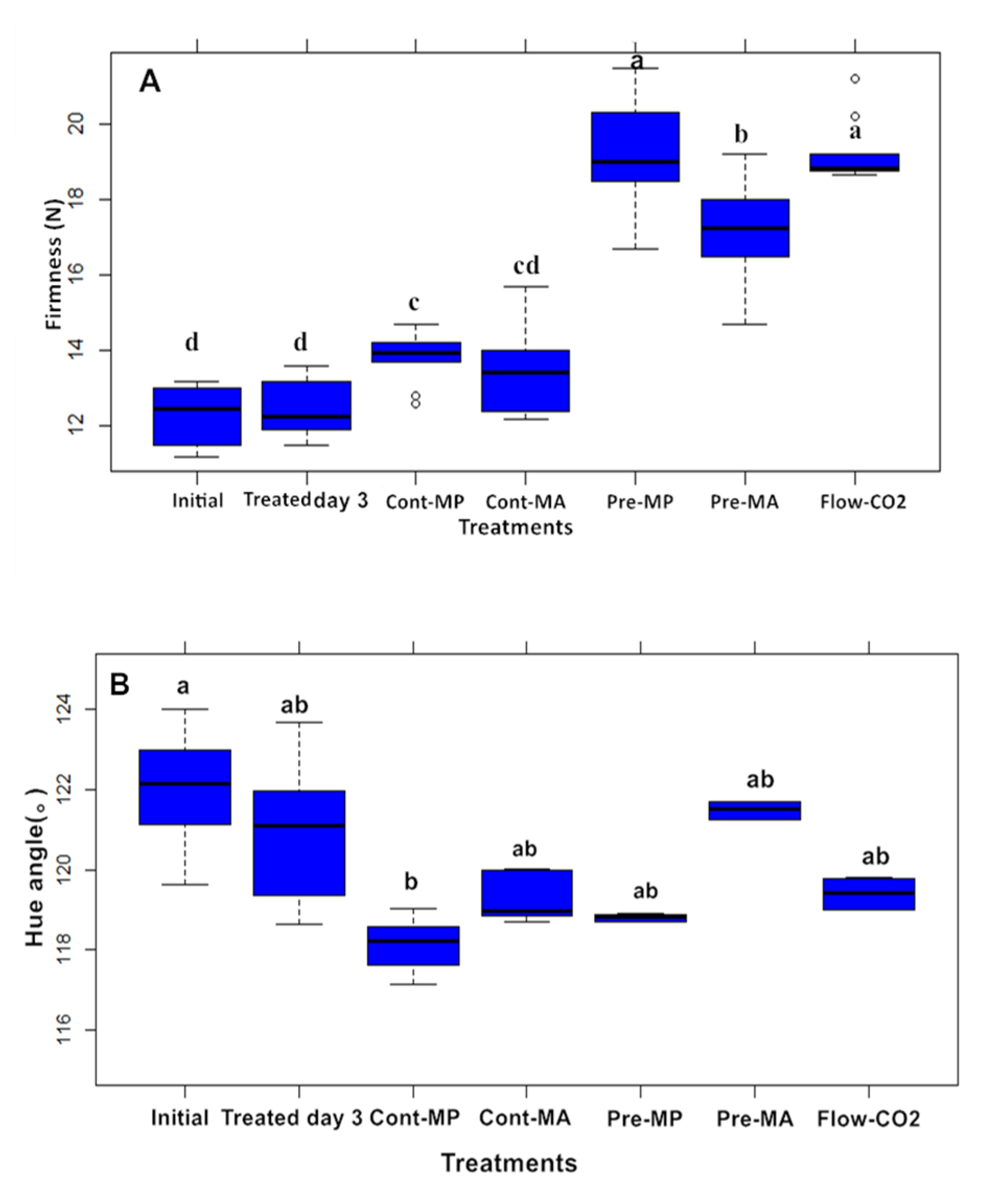
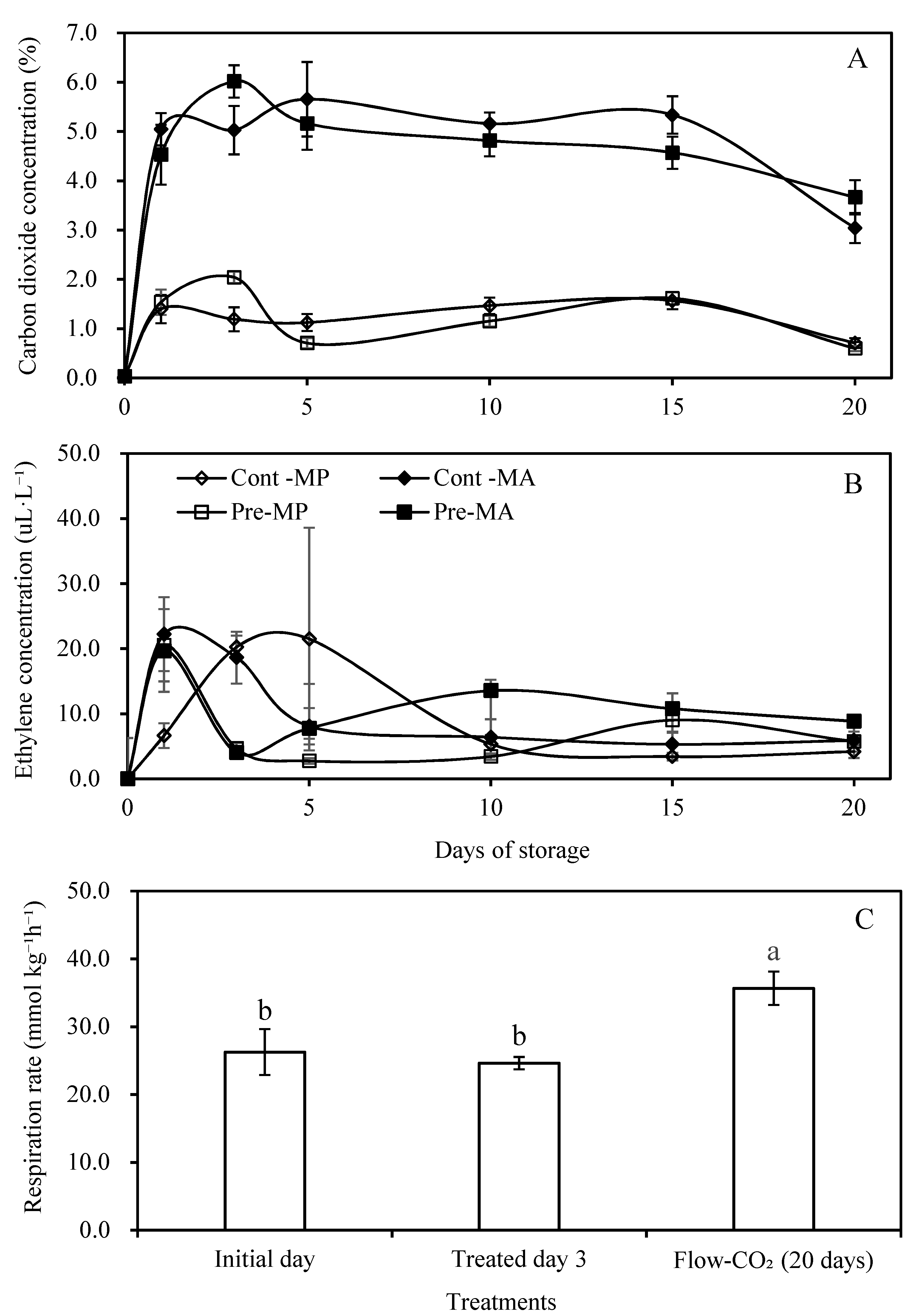
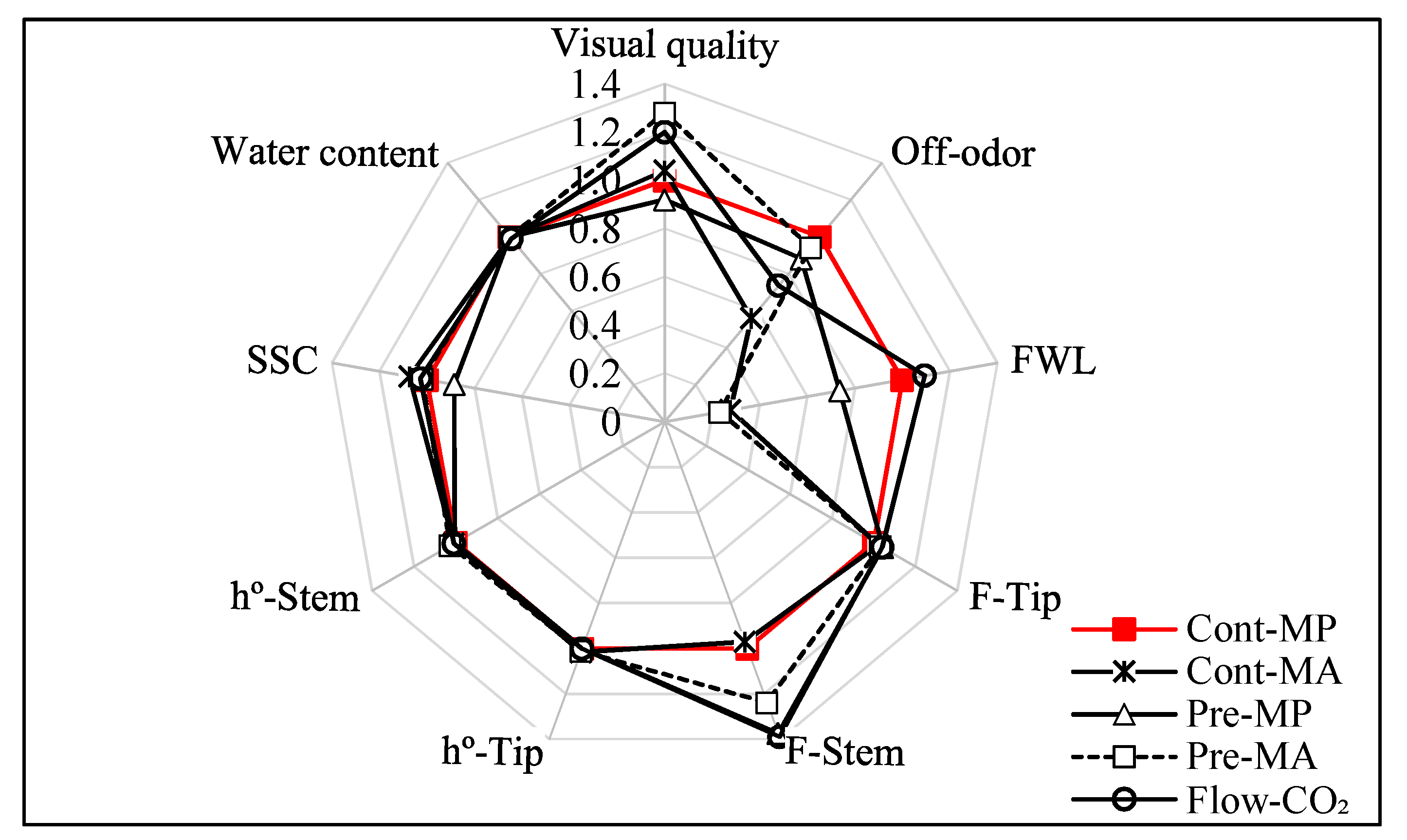
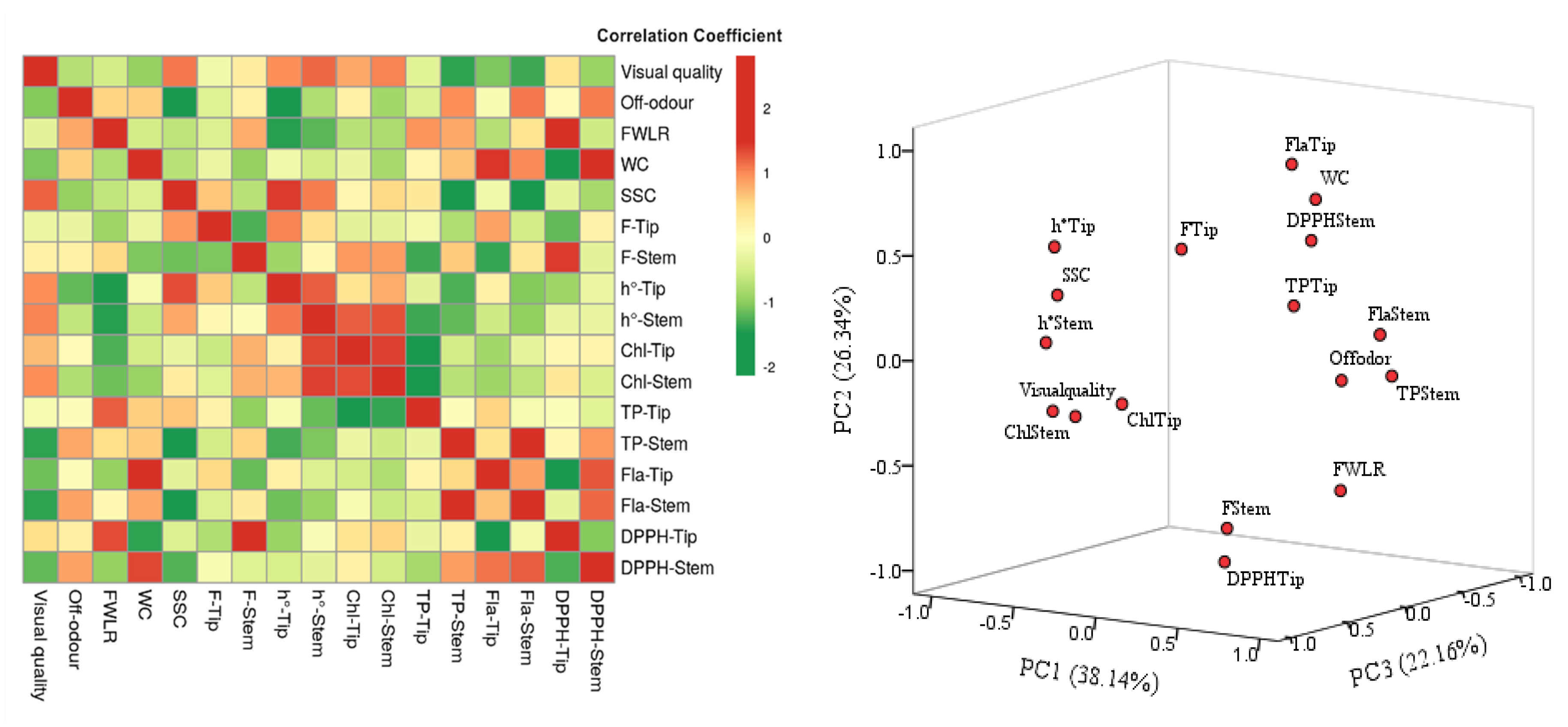
| Treatments | Chlorophyll Content (mg·mL⁻¹) | ΔE* | ||
|---|---|---|---|---|
| Tip | Stem | Tip | Stem | |
| Initial day | 5.66 a | 2.18 a | - | - |
| Treated day 3 | 4.84 b | 1.98 c | 6.63 c | 6.54 b |
| Cont -MP | 3.23 f | 1.12 g | 9.35 b | 10.23 a |
| Cont -MA | 3.09 g | 1.74 f | 8.34 bc | 10.30 a |
| Pre-MP | 3.76 d | 1.84 e | 13.38 a | 5.19 c |
| Pre-MA | 4.68 c | 2.11 b | 7.29 bc | 8.91 a |
| Flow-CO₂ | 3.62 e | 1.89 d | 6.25 c | 8.20 ab |
| Treatments | SSC (°Brix) | Total Phenol (U·g⁻¹) | Flavonoids (U·g⁻¹) | DPPH (%) |
|---|---|---|---|---|
| Initial day | 6.19 a | 0.72 c | 0.68 e | 85.67 c |
| Treated day 3 | 5.58 b | 0.82 a | 0.91 a | 92.67 a |
| Cont-MP | 4.93 c | 0.67 d | 0.58 g | 56.97 e |
| Cont-MA | 5.30 bc | 0.79 b | 0.61 f | 73.73 d |
| Pre-MP | 4.37 d | 0.80 ab | 0.72 d | 71.88 d |
| Pre-MA | 5.03 c | 0.81 a | 0.74 c | 88.64 b |
| Flow-CO₂ | 5.07 c | 0.81 a | 0.76 b | 91.18 ab |
| Treatments | Growth of Microorganisms ( log CFU·g⁻¹) | ||
|---|---|---|---|
| Total Aerobic Bacteria | E. coli | Yeast and Mold | |
| Initial day | 3.26 bc | 2.71 c | 0.00 b |
| Treated day 3 | 2.10 c | 3.50 b | 0.00 b |
| Cont-MP | 5.76 a | 4.31 a | 2.10 a |
| Cont-MA | 4.58 ab | 4.20 a | 0.00 b |
| Pre-MP | 4.75 ab | 3.34 b | 0.00 b |
| Pre-MA | 4.56 ab | 3.45 b | 0.00 b |
| Flow-CO₂ | 2.16 c | 3.01 bc | 0.00 b |
| Quality Attributes | CO₂ | Package | CO₂ × Package |
|---|---|---|---|
| p-Value | p-Value | p-Value | |
| Visual quality | 0.06 | 0.03 z* | 0.07 |
| Off-odor | 0.04 * | 0.03 * | 0.00 ** |
| Fresh weight loss | 0.00 ** | 0.00 ** | 0.00 ** |
| Water content | 0.00 ** | 0.59 | 0.47 |
| SSC | 0.00 ** | 0.00 ** | 0.00 ** |
| F-Tip y | 0.32 | 0.77 | 0.41 |
| F-Stem | 0.00 ** | 0.03 * | 0.16 |
| h°-Tip | 0.25 | 0.02 * | 0.43 |
| h°-Stem | 0.00 ** | 0.00 ** | 0.00 ** |
Publisher’s Note: MDPI stays neutral with regard to jurisdictional claims in published maps and institutional affiliations. |
© 2020 by the authors. Licensee MDPI, Basel, Switzerland. This article is an open access article distributed under the terms and conditions of the Creative Commons Attribution (CC BY) license (http://creativecommons.org/licenses/by/4.0/).
Share and Cite
Wang, L.-X.; Choi, I.-L.; Kang, H.-M. Correlations among Quality Characteristics of Green Asparagus Affected by the Application Methods of Elevated CO₂ Combined with MA Packaging. Horticulturae 2020, 6, 103. https://doi.org/10.3390/horticulturae6040103
Wang L-X, Choi I-L, Kang H-M. Correlations among Quality Characteristics of Green Asparagus Affected by the Application Methods of Elevated CO₂ Combined with MA Packaging. Horticulturae. 2020; 6(4):103. https://doi.org/10.3390/horticulturae6040103
Chicago/Turabian StyleWang, Li-Xia, In-Lee Choi, and Ho-Min Kang. 2020. "Correlations among Quality Characteristics of Green Asparagus Affected by the Application Methods of Elevated CO₂ Combined with MA Packaging" Horticulturae 6, no. 4: 103. https://doi.org/10.3390/horticulturae6040103
APA StyleWang, L.-X., Choi, I.-L., & Kang, H.-M. (2020). Correlations among Quality Characteristics of Green Asparagus Affected by the Application Methods of Elevated CO₂ Combined with MA Packaging. Horticulturae, 6(4), 103. https://doi.org/10.3390/horticulturae6040103






